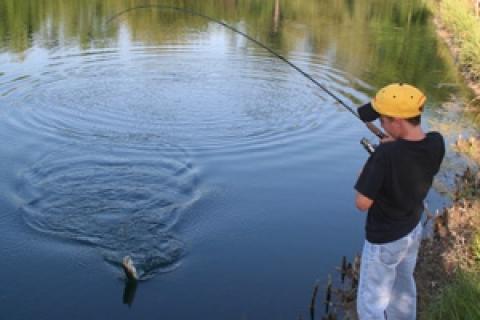
 A common scene around a campground is an angler or two perched at the water's edge with fishing pole in hand. For some bank-side fishermen, the time spent at the water is merely relaxation, and for others, well, they want to regularly catch fish. A crispy panfish fillet is always a treat back at camp, which typically inspires more fishing time. Here are a few tips to improve your chances of putting a fish dinner on the picnic table.
A common scene around a campground is an angler or two perched at the water's edge with fishing pole in hand. For some bank-side fishermen, the time spent at the water is merely relaxation, and for others, well, they want to regularly catch fish. A crispy panfish fillet is always a treat back at camp, which typically inspires more fishing time. Here are a few tips to improve your chances of putting a fish dinner on the picnic table.
1. Observe the Water
Unless you're familiar with a body of water or have been given tips by fellow campers, the bait shop or campground host, it's unlikely you'll be able to hike up to a pond or lake, take a quick look left and right up and down the shoreline, set up at a selected spot and start catching fish within minutes. But with a little practice of giving a water body a couple minutes review, more fish will come to hand.
Study the water edge and all structure visible. Watch the water surface closely for any activity, either insects or fish. If possible, move along the shoreline every 10 minutes or so. If still no action, cast as far out as you can and slowly and systematically work the bait back to you. Change your speed of lure retrieve occasionally to spark a strike. If fishing live bait, crank your rig in a few feet every few minutes, which may entice a hesitant fish to bite.
2. Get Edgy
By moving along the shoreline, you're covering more water by not anchoring yourself to one location. Narrow the possibilities even further. Gamefish normally hang near edges. Weed bed edges, dock edges, shade lines, the seam where cooler and warmer water meets, and similar scenarios that create an edge. Bass and other ambushing predator fish cruise or patiently hold in the edge of a shadow or weed forest, waiting for a meal.
Downed trees or brush touching the water surface or partially submerged are fish magnets. Baitfish congregate around this type of structure and so do the baitfish eaters. Dock and bridge pilings offer the same scenarios. Cast your offering as close to the edge as possible.
3. Keep Live Bait Alive
Artificial lures work well and provide an arsenal of fish catching tools for various fishing conditions. But if your artificial lure fishing skills are not putting fish on hook, then turn to live bait rigs. Live bait rigs vary, but the most important element of live bait fishing is keeping the bait fresh.
Minnows and other live baitfish are easily kept alive for a couple hours in a foam bait bucket with an inexpensive aerator in use. Use a clean 5-gallon bucket. Insert a foam bait bucket inside the 5-gallon bucket and add a bag of ice on top of the foam bucket. There is ample room for the battery-powered aerator and ice to lie on the foam bucket. Periodically add a few pieces of ice to the water in the foam bucket to keep the baitfish lively.
- 2693 views

